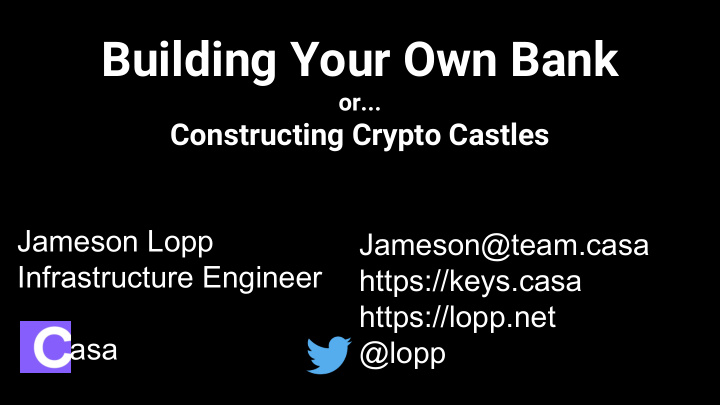



Building Your Own Bank or... Constructing Crypto Castles Jameson Lopp Jameson@team.casa Infrastructure Engineer https://keys.casa https://lopp.net asa @lopp
A History Rife with Failure An estimated 4,000,000+ BTC lost. An estimated 2,000,000+ BTC stolen.
Issues of Personal Responsibility ● Few folks think about self defense because they aren’t big targets ● Few folks have much more protecting them at home than a few walls and doors that are easily breached by a motivated attacker ● No way to reverse theft of bearer assets means more motivated attackers ● If everyone fails at securing their assets, they won’t be worth much
Attacks Defenses Physical Theft Safes, hidden storage, guards Digital Theft Offline storage Physical disaster Redundant storage Social Engineering Education, Paranoia Collusion Trust Minimization
Key Holding Risks User holds key OR Service holds key ● Malware ● Malware ● Weak password ● Hacks ● Coercion ● Insider theft ● Death of owner ● Fractional reserve ● Data loss ● Government seizure ● Forgotten password ● Data loss ● Phishing ● Frozen by service ● Phishing
Key Holding Risks User holds key AND Service holds key (2-of-2) ● Malware ● Malware ● Weak password ● Hacks ● Coercion ● Insider theft ● Death of owner ● Fractional reserve ● Data loss ● Government seizure ● Forgotten password ● Data loss ● Phishing ● Frozen by service ● Phishing
Key Holding Risks User holds multiple keys AND Service holds key (2-of-3, 3-of-5…) ● Malware ● Malware ● Weak password ● Hacks ● Coercion ● Insider theft ● Death of owner ● Fractional reserve ● Data loss ● Government seizure ● Forgotten password ● Data loss ● Phishing ● Frozen by service ● Phishing
Security Engineering Objectives 1. Protect users from trusted third parties. 2. Protect users from attackers. 3. Protect users from themselves. It’s preferable for a user to temporarily lose access to their funds than for an attacker to temporarily gain access.
Security Engineering Objectives 1. Protect users from trusted third parties. 2. Protect users from themselves. 3. Protect users from attackers. If we push security out to the edges of the network, users are more likely to experience loss due to negligence rather than attack.
How to Build a Bitcoin Bank Step 1: Write down this 24 word seed phrase and keep it safe.
How to Build a Bitcoin Bank Step 1: Write down this 24 word seed phrase and keep it safe.
Users Shouldn’t Handle Seeds
Seedless Recovery
Paper Wallets are Prone to Failure ● Hard to generate private keys securely ● Loss to physical attackers if unencrypted ● Loss due to environmental factors ● Loss due to improper transaction construction / single key sweeping
Metal Wallets are Prone to Failure ● Loss to physical attackers if unencrypted ● Loss due to environmental factors ● Loss due to improper transaction construction / single key sweeping
Add Redundancy: Eliminate SPoF Multi-signature Multi-device Multi-location
My Personal (pre-Casa) Solution 1. Create encrypted file container on airgapped machine with VeraCrypt 2. Encrypt container with a randomly generated long passphrase that you generate via rolling dice 3. Use ssss to split the decryption passphrase into your preferred setup. This mainly depends upon how many trusted friends and family you’re willing to store the encrypted data and decryption shards with. You also want enough redundancy that your M of N scheme doesn’t become useless if a member or two loses their data or dies / is no longer able to participate in a recovery ceremony. 4. Copy file onto N USB drives and place one ssss shard on each drive 5. Hand out USB drives in faraday bags to will executors. 6. Update annually to protect against bitrot. 7. Write down what you have done and provide detailed step-by-step instructions for how to recover the data if you’re no longer around. 8. MAKE SURE YOU TEST YOUR INSTRUCTIONS .
Complexity is the Enemy of Security We aren’t just engineering financial applications for motivated, enthusiastic users. We’re also engineering them for the less savvy heirs who may have to execute a recovery.
How to Build a Bitcoin Bank / Crypto Castle Use the basic building blocks: ● Air gaps are the moat ● Strong crypto / multisig are the stone walls ● Hardware key managers are the portcullis ● Wallet software is the gatehouse ● Automated alerts are the watchtowers ● A simple duress kill switch is the drawbridge
Trust Minimization Low Trust High Trust Low Convenience High Convenience Push security to the edges Simple full node integration is preferable
User Friendliness Software should bake in best practices to educate & guide the user. Visual representations of security make it more real.
Ignorance Protection Some users will get tricked or otherwise compromised. It’s hard to stop social engineering. Solutions: Remind user to verify address out of band with counterparty. OP_CHECKLOCKTIMEVERIFY Malware blacklists Reputation features & covenants
Begin Building Your Crypto Castle Today!
Questions? Jameson Lopp Jameson@team.casa Infrastructure Engineer https://keys.casa https://lopp.net asa @lopp
Recommend
More recommend